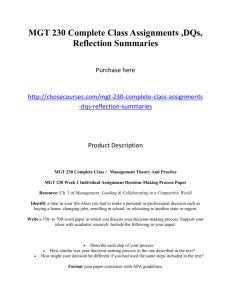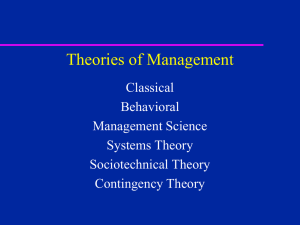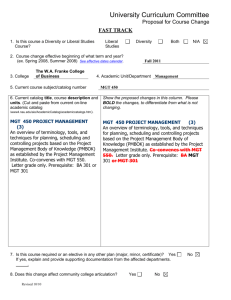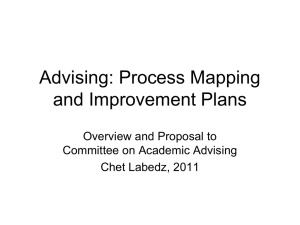Chapter #12 Managing Chronic Conditions
advertisement
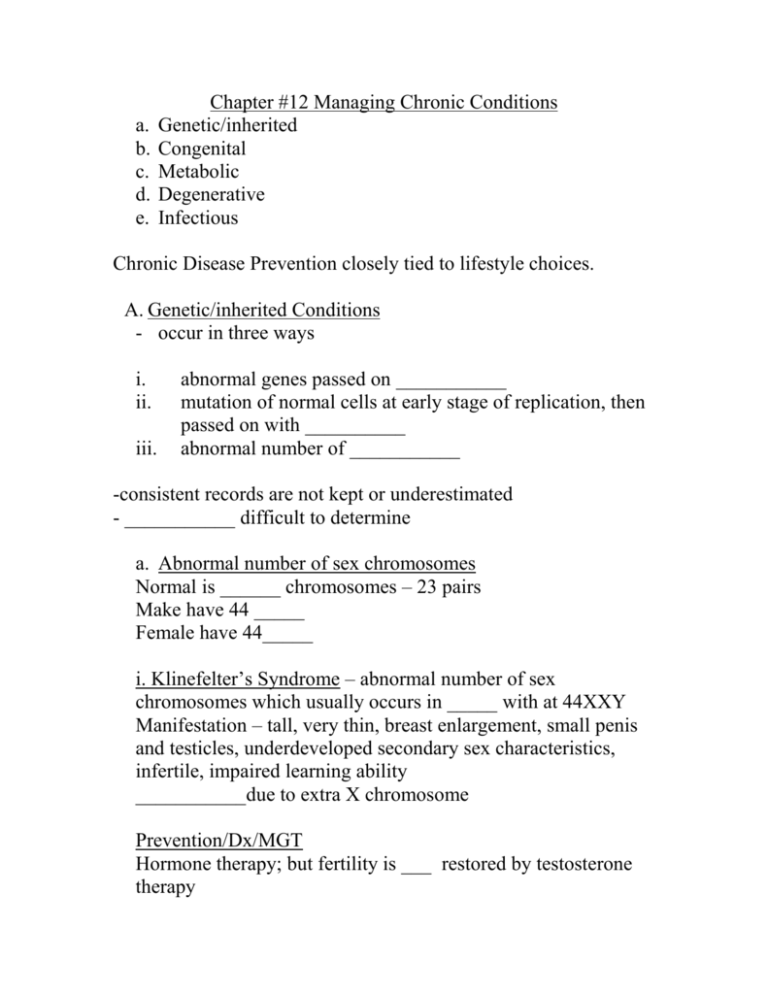
a. b. c. d. e. Chapter #12 Managing Chronic Conditions Genetic/inherited Congenital Metabolic Degenerative Infectious Chronic Disease Prevention closely tied to lifestyle choices. A. Genetic/inherited Conditions - occur in three ways i. ii. iii. abnormal genes passed on ___________ mutation of normal cells at early stage of replication, then passed on with __________ abnormal number of ___________ -consistent records are not kept or underestimated - ___________ difficult to determine a. Abnormal number of sex chromosomes Normal is ______ chromosomes – 23 pairs Make have 44 _____ Female have 44_____ i. Klinefelter’s Syndrome – abnormal number of sex chromosomes which usually occurs in _____ with at 44XXY Manifestation – tall, very thin, breast enlargement, small penis and testicles, underdeveloped secondary sex characteristics, infertile, impaired learning ability ___________due to extra X chromosome Prevention/Dx/MGT Hormone therapy; but fertility is ___ restored by testosterone therapy ii. Turner’s Syndrome Occurs in _______ (1 in 5,000) with 44X0 – absence of second X chromosome Equivalency to ________ – infertility, diminished secondary sex characteristics iv. Supermasculinity 1 in 1,000 male births with 44XYY – slightly taller and more ____________ v. Cystic Fibrosis (inherited) Affects children with 1 in 2,000 Births – life expectancy up to age ____– important bodily functions are disrupted like digestive ________ – increased mucous production and conservation of electrolytes – Serious problems with __________ and digestion Prevention/Dx/MGT Usually Dx in _______ with combination of symptoms; poor growth, foul smelling stools, chronic coughing/wheezing, recurrent pneumonia, nasal polyps, enlarged fingertips, skin that has a salty taste Dx is through a _______ test – Incurable, life-shortening; special diets developed to support weight and maintain growth Needs include respiratory therapy, inhaled antibiotics, vaccines and drug combos- On the horizon is __________ VI.Tay Sach’s Disease (inability to metabolize fat) - _____of genetic diseases – seen in Eastern European _____ - children appear normal at birth but signs of neurological abnormalities develop by age 6 - includes blindness, deafness, muscle ______, paralysis and inability to swallow - Symptoms – also include _______speech, cramps, tremors and sometimes mental illness - Death usually occurs around age 15 (______ lodged in brain) Prevention, Dx and MGT - have carrier status detected through genetic testing VII. Sickle Cell Anemia - abnormal __________– more prominent in _______ - shortened life expectancy with periods of pain and impairment - 8% of Blacks carry this trait - ________ shaped RBC unable to diffuse through capillaries - Body removes cells quickly leading to ________ - Results in impaired lung function, _________ heart failure, gallbladder infections, bone changes, abnormalities of skin and eyes - Px lives up to_____ years of age Prevention/Dx/Treatment - easily diagnosed with symptoms appearing after two years of age via blood test - MGT by physical and occupational therapy - Disease is ___________ - If disease if found in a woman, it is through genetic mutation and not inherited B. CONGENTIAL ABNORMALITIES - abnormalities present at birth – due to tissue changes during embryonic development - forms early _____________ranging in degree of severity - causes considered multi-factoral – genetics and environment i. Clubfoot 1 in 1,000 with curved foot and prominent arches possibly caused by early _____________ Prevention/Dx/ MGT -manipulating feet with plaster casts - tendon surgery, multiple splintings/castings - stretching exercises ii. - Cleft Palate/Cleft Lip failure of lip and roof of mouth to ______ 1 in 800 births with cause unknown possibly certain medications (___________) Use of alcohol and smoking Corrected with surgeries Prevention, Dx, MGT - Dx at delivery with treatment determined by a number of specialists - Lip surgery at 3-4 months - Cleft palate done before 2nd birthday - If nasal and throat structures are malformed – more surgery iii. Patent Foramen Ovale (PFO) - 1 in 5 births - hole ________ ventricles does not close completely - it is rarely identified and not harmful unless there is a ______ of blood “Blue” blood or “blue” baby - possible cyanosis and heart ______ Prevention, Dx, MGT - no treatment needed unless other heart abnormalities exist - possible problems with ________ changes (scuba diving, planes, etc) iv. Scoliosis -abnormal spine _____________ - no known cause - begins as curvature to the side - entire _________ Cavity can be affected – compress heart/lungs Prevention/Dx/MGT - screening begins in elementary school - treated by orthopedic surgeons – (?chiropractors?) a. do nothing b. use a brace (25-30 degrees) c. undergo surgery > 45 degrees) C. METABOLIC DISORDERS - Caused by boy’s inability to control _______processes which results in abnormal functions and genetic predispositions i. - Non-insulin dependent diabetes milletus (Type _) problem with glucose ________ a genetic predisposition with insulin levels triggers mechanism for obesity and inactivity build-up of glucose in blood – ______________ removal of excess glucose in _______ excessive ________ Prevention/Dx/MGT - dietary modification - regular exercise - borderline is controlled with some oral meds - monitoring unresolved stress and depression can increase glucose levels - generally glucose _________ with RNA receptor at site of blood diffusion ii. Insulin-dependent diabetes milletus (Type 1) - childhood onset - body produces no ________ Prevention/Dx/MGT - use of insulin from outside source as body fails to produce product - pump or ___________ - use glucometer at home; but future methods may include inhalation, powdered forms, insulin __________ - the use of insulin is no replacement for sound diet, exercise, and stress MGT. (diabetes complications – p. 397) iii. Hypoglycemia – Low Blood Sugar - headaches, mild confusion, low energy levels, anxiety, sweating, tremors, behave abnormally - can be X-er to diabetics or non-diabetics v. PKU (Phenylketonuria) - recessive genetic disorder with inability to convert phenylalaline to tyrosine which results in effects to __________system - twitching, spasms, contractures, restless leg syndrome, inability to sleep, figidity habits, blank _______ Prevention/Dx/MGT - all infants tested at birth – cannot eat meat, fish, poultry, milk, eggs, cheese, dairy, beans, nuts, bakery products - babies feed ________ formulas, shifts to formulated low protein foods (through feeding tube) - fruits, vegetables and some grains - over time phenylalanine can be added to diet - restricted diet throughout life D. Degenerative Diseases - diagnosed later in life with both functional and structural wasting iv. Fibromyalgia - symptoms include morning stiffness, muscle pain, fatigue, numbness and tingling, poor sleep, jaw discomfort and _______ headaches - altered ___________ regulation, hormonal dysfunction caused by trigger events such as infection, emotional stress, physical trauma, thyroid ____________ and connective tissue disorders Prevention/Dx/MGT - reduce stress, avoid infections, check 18 bodily tender points when discomfort levels are up - improve sleep with meds - reduce pain via acupuncture, therapeutic massage - _____________, calcium citrate and brewer’s yeast - Condition is chronic with periods of remission vi. Asthma - chronic respiratory disease with acute attacks of breathlessness and wheezing - chronic airway inflammation (genetic disposition?) a. _________ asthma - most common, through __________ conditions such as pollen, dust, molds, exercise, smoke , certain foods and drugs can cause a reaction b. ___________asthma - caused by stress or frequent respiratory ___________ Prevention/Dx/MGT - Sound diet, exercise (moderate), stress mgt, inhalants/_______________, herbal teas vii. Crohn’s Disease - form of inflammatory _________disease - deterioration of intestinal ___________ - symptoms include abdominal pain, fever, diarrhea, weight loss and rectal ____________ - caused by genetic predisposition, emotional stress and __________ response to foodstuffs and liquids Prevention/Dx/MGT - blood test and GI series, ___________ colon exam, treatment through medications, surgery may be necessary to remove obstruction due to ____________ intestinal walls - Use of _______________controversial viii. Systemic _______ Erythematosus (SLE) - autoimmune disorder which attacks body’s own tissues; more often seen in women during young _________; higher among ___________ - genetic predisposition and emotional stress onset - symptoms include periods of inflammation, stiffness, fatigue, pleurisy, discomfort in muscles, skin, joints Prevention, Dx, MGT - biopsy of skin rash, prednisone, blood test, Vitamin B6, amino acid tryptophane ix. Multiple Sclerosis - systemic __________ damage with resultant impaired movement - mental deterioration - treatment by reducing severity of symptoms and extending remission - often accompanied by __________ x. Parkinson’s Disease - loss of muscular __________ with trembling, stiffness in limbs and trunk, slowness and impaired ____________ - slow progression with DLA after age of _______ - caused by buildup of free ________, environmental toxins with an inherited predisposition - (Michael J. Fox) Prevention/Dx/MGT - diagnosed by neurologist – meds used to slow development - some electrode stimulus – TENS – for tremors, __________ xi. Alzheimer’s Disease (AD) - often confused with mild _______, with person being forgetful, confused, _________, infantile behavior like incontinence Prevention/Dx/MGT - Medications to prevent _______damage
